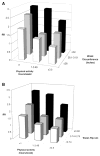Obesity as compared with physical activity in predicting risk of coronary heart disease in women
- PMID: 16449729
- PMCID: PMC3210835
- DOI: 10.1161/CIRCULATIONAHA.105.574087
Obesity as compared with physical activity in predicting risk of coronary heart disease in women
Abstract
Background: The comparative importance of physical inactivity and obesity as predictors of coronary heart disease (CHD) risk remains unsettled.
Methods and results: We followed 88 393 women, 34 to 59 years of age, in the Nurses' Health Study from 1980 to 2000. These participants did not have cardiovascular disease and cancer at baseline. We documented 2358 incident major CHD events (including nonfatal myocardial infarction and fatal CHD) during 20 years of follow-up, including 889 cases of fatal CHD and 1469 cases of nonfatal myocardial infarction. In a multivariate model adjusting for cardiovascular risk factors, overweight and obesity were significantly associated with increased risk of CHD, whereas increasing levels of physical activity were associated with a graded reduction in CHD risk (P<0.001). In joint analyses of body mass index (BMI) and physical activity in women who had a healthy weight (BMI, 18.5 to 24.9 kg/m2) and were physically active (exercise > or =3.5 h/wk) as the reference group, the relative risks of CHD were 3.44 (95% confidence interval [CI], 2.81 to 4.21) for women who were obese (BMI > or =30 kg/m2) and sedentary (exercise <1 h/wk), 2.48 (95% CI, 1.84 to 3.34) for women who were active but obese, and 1.48 (95% CI, 1.24 to 1.77) for women who had a healthy weight but were sedentary. In combined analyses of waist-hip ratio and physical activity, both waist-hip ratio and physical activity were significant predictors of CHD, and the highest risk was among women in the lowest category of physical activity and the highest tertile of waist-hip ratio (relative risk=3.03; 95% CI, 1.96 to 4.18). Even a modest weight gain (4 to 10 kg) during adulthood was associated with 27% (95% CI, 12% to 45%) increased risk of CHD compared with women with a stable weight after adjusting for physical activity and other cardiovascular risk factors.
Conclusions: Obesity and physical inactivity independently contribute to the development of CHD in women. These data underscore the importance of both maintaining a healthy weight and regular physical activity in preventing CHD.
Figures


References
-
- Mosca L, Appel LJ, Benjamin EJ, Berra K, Chandra-Strobos N, Fabunmi RP, Grady D, Haan CK, Hayes SN, Judelson DR, Keenan NL, McBride P, Oparil S, Ouyang P, Oz MC, Mendelsohn ME, Pasternak RC, Pinn VW, Robertson RM, Schenck-Gustafsson K, Sila CA, Smith SC, Jr, Sopko G, Taylor AL, Walsh BW, Wenger NK, Williams CL. Evidence-based guidelines for cardiovascular disease prevention in women. Arterioscler Thromb Vasc Biol. 2004;24:e29–e50. - PubMed
-
- Wessel TR, Arant CB, Olson MB, Johnson BD, Reis SE, Sharaf BL, Shaw LJ, Handberg E, Sopko G, Kelsey SF, Pepine CJ, Merz NB. Relationship of physical fitness vs body mass index with coronary artery disease and cardiovascular events in women. JAMA. 2004;292:1179–1187. - PubMed
-
- Hu FB, Willett WC, Li T, Stampfer MJ, Colditz GA, Manson JE. Adiposity as compared with physical activity in predicting mortality among women. N Engl J Med. 2004;351:2694–2703. - PubMed
-
- Willett WC, Sampson L, Stampfer MJ, Rosner B, Bain C, Witschi J, Hennekens CH, Speizer FE. Reproducibility and validity of a semiquantitative food frequency questionnaire. Am J Epidemiol. 1985;122:51–65. - PubMed
-
- Willett W, Stampfer MJ, Bain C, Lipnick R, Speizer FE, Rosner B, Cramer D, Hennekens CH. Cigarette smoking, relative weight, and menopause. Am J Epidemiol. 1983;117:651–658. - PubMed
Publication types
MeSH terms
Grants and funding
LinkOut - more resources
Full Text Sources
Medical

